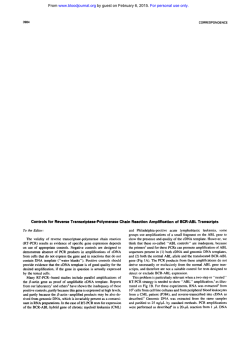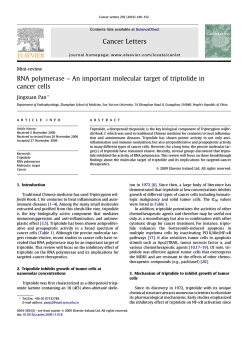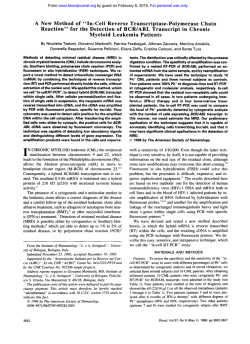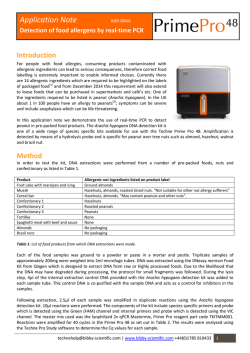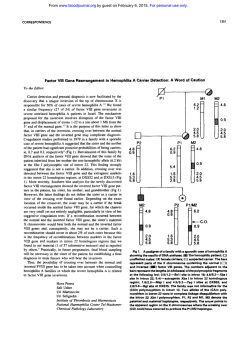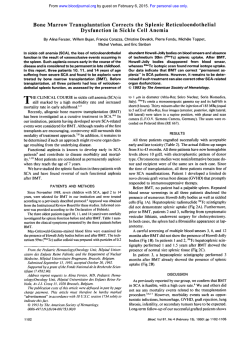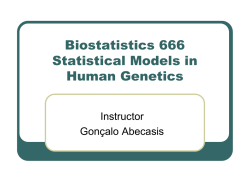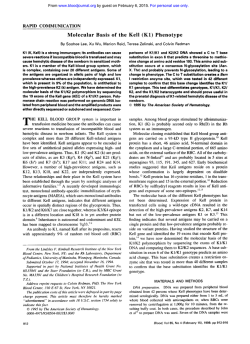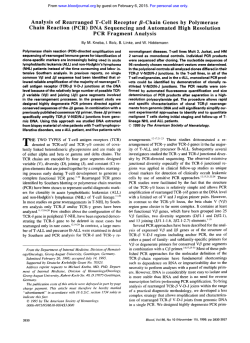
Comparison of Genomic DNA and cDNA for Detection of
From www.bloodjournal.org by guest on February 6, 2015. For personal use only. Comparison of Genomic DNA and cDNA for Detection of Residual Disease After Treatment of Chronic Myeloid Leukemia With Allogeneic Bone Marrow Transplantation By Ji Guang Zhang, Feng Lin, Andrew Chase, John M. Goldman, and Nicholas C.P. Cross To test whether patients in remission after allogeneic bone marrow transplantation (BMT) possess apool ofchronic myeloid leukemia (CML) cells that do not express BCR-ABL mRNA, we have compared the results and sensitivity of amplification of BCR-ABL from genomic DNA with conventional reverse transcription-polymerase chain reaction (RT-PCR). Bubble PCR was usedt o amplify the genomic BCR-ABLtranslocation breakpoints from chronic-phase DNA of 10 patients with CML who subsequently underwent BMT. After cloning and sequencing of the amplification products, patient-specific ABL primers weresynthesized and tested for both specificity and sensitivity in nested or heminested combinations with a variety of primers derived from themajor breakpoint cluster region of the BCR gene. In all cases, combinations of primers were selected that enabled the detection of chronic-phase DNA from a specific patient at up t o a 105x dilution into DNA from a normal individual. Patterns of residual disease obtained by serial RT-PCR and DNA-PCR analyses of blood and bone marrow samples obtained after BMT were similar for most patients, including one treated for relapse by infusion of donor leukocytes. Of the 24 samples for direct comparison of RT-PCR and DNA-PCR, results were concordant in 19 (7946) cases. Five results were discordant. In two instances, RT-PCR was positive, while PCR from genomic DNA was negative; this discrepancy might have arisen due t o the slightly greater sensitivity of RT-PCR compared with DNA-PCR. Inthree samples from three patients, two of whom had been transplanted in the accelerated phase, PCR from genomic DNA was positive while RT-PCR was negative; this could mean that some CML cells in these samples had a reduced or absent capacity t o express BCR-ABL mRNA posttransplant. Of these three patients, one subsequently relapsed; and two are in remission at 21 and 24 months after the discordant result. Thus, the finding of a single DNA-PCRpositive, RT-PCR-negative result does not necessarily predict relapse. Because the great majority of samples (79%) gave concordant results with the two assays, we believe that patients in remission do notgenerally harbor a substantial pool of CML cells that do not express BCR-ABL mRNA. 0 1996 by The American Society of Hematology. C scription of leukocyte RNA followed by amplification (RTPCR). While RT-PCR can identify groups of patients with an elevated risk of relapse, many patients are PCR-positive for several months or longer after BMT without subsequent relapse. Thus, this qualitative technique is of limited value in the clinical management of individual We and others have, therefore, developed a competitive PCR assay to quantitate BCR-ABL transcripts and have shown that rising levels of the fusion gene mRNA can be observed before detection of relapse at the cytogenetic l e ~ e l . ” ~ ‘ ~ It has recently been suggested that some Ph-positive CML cells may notactively express the BCR-ABL fusion Such cells would escape detection by RT-PCR but could be detectable by methods that recognize the rearrangement in genomic DNA. It is conceivable that transcriptionally silent CML cells are present in patients after BMT and, after reactivation, could contribute to relapse. To test the hypothesis that CML patients after BMT possess a pool of leukemia cells that do not express BCR-ABL mRNA, we have compared results of residual disease detected by RT-PCR with results obtained by amplification of BCR-ABL breakpoints from genomic DNA. HRONIC MYELOID leukemia (CML) can be cured by allogeneic bone marrow transplantation (BMT) in the majority of cases, but some patients will relapse.’.’ Cure is not achieved solely by high-dose chemoradiotherapy, but also involves elimination or suppression of the leukemic clone by an ill-defined graft-versus-leukemia (GVL) effect.l There is some evidence to suggest that the Philadelphia chromosome (Ph)-positive clone is suppressed rather than totally eradicated. First, evidence of residual disease has been found by reverse transcription-polymerase chain reaction (RTPCR) in some long-term survivors after BMT.4,s Second, BCR-ABL-positive myeloid progenitor cells have been identified in some patients who remain in sustained remission.‘,’ Third, two female patients have been recently described who relapsed during or shortly after pregnancy despite having been in remission for 4.25 and 6.5 years after allogeneic BMT for CML.8,9It is possible that the immunosuppression associated with pregnancy” abrogated GVL, enabling a dormant or suppressed leukemia clone to re-emerge. There has been considerable interest in the use of the PCR to detect residual disease in CML patients after BMT. Several groups have demonstrated that BCR-ABL mRNA may be specifically and efficiently detected by reverse tran- From theLRF Leukaemia Unit, Royal PostgraduateMedical School, Hammersmith Hospital, London, UK. Submitted July 24, 1995; accepted November 3, 1995. Address reprint requests to Nicholas C.P. Cross, PhD, LRF Leukaemia Unit, Departmentof Haematology, Royal Postgraduate Medical School, Ducane Rd, London W12 ONN, UK. The publication costsof this article were defrayedin part by page charge payment. This article must therefore be hereby marked “advertisement” in accordance with 18 U.S.C. section 1734 solely to indicate this fact. 0 1996 by The American Society of Hematology. 0006-4971/96/8706-0$3.00/0 2588 MATERIALS AND METHODS Patients. Ten patients with CML who had undergone allogeneic BMT were studied. At the time of transplant, eight patients were in chronic phase, and two were in accelerated phase. Four patients received grafts from HLA-identical sibling donors and six from unrelated volunteer donors. The conditioning regimen in all groups included cyclophosphamide 120 mgkg and fractionated total body irradiation to a total dose of 10, 12, or 13.2 Gy at a dose rate of 15 cGylmin. All patients received cyclosporin A (CSA) plus methotrexate (MTX) as graft-versus-host disease prophylaxis, and those with unrelated donors also underwent in vivo T-cell depletion using Campath 1G.” One patient relapsed and was treated by donor leukocyte transfusion (DLT).’~ Cytogenetic analysis. Cytogenetic analysis of marrow cells was Blood, Vol 87, No 6 (March 15). 1996: pp 2588-2593 From www.bloodjournal.org by guest on February 6, 2015. For personal use only. DNA VERSUS cDNA FOR DETECTION OF MRD IN CML performed routinely on all patients at3. 6. 9, and 12 months posttransplant and subsequently at h-month intervals whenever possible. At least 30 consecutive metaphases were studied. All patients were Ph-positive before BMT. RT-PCR,fiwRCR-ARL. Peripheral blood or bone marrow cells were studied prospectively at various intervals posttransplant. Informed consent was obtained as required by the Declaration of Helsinki. After extraction of leukocyte RNA. samples were tested for the presence of BCR-ABL mRNA by reverse transcription followed by nested PCR.'" BCR-ABL transcripts were quantified in IS of the 16 RT-PCR-positive specimens by competitive PCR." Results were standardized by deriving the number of BCR-ABL transcripts per microgram leukocyte RNA. PCR-positive samples werc scored as having less than 1 0 BCR-ABL transcripts per microgram RNAif the competitor band predominated at I O molecules of compctitor added. High BCR-ABL levels were defined as S0 transcripts per microgram RNA or greater; detectable butlow BCR-ABL levels had less than S0 transcripts per microgram RNA. Using competitive PCR,wehave previously demonstrated concordance in levels of residual disease between blood and bone marrow.'' Cloninx rrnd characterizrrtion qf RCR-ARLbreokpoints. Characterization of genomic DNA breakpoints for patients M.L., D.M., A.H., M.T., A.J.,A.L..andA.E. by bubble PCR has been described in detail elsewhere.'' Breakpoints for patients B.Y., B.M.. and R.K. were determined in exactly the same way. Briefly, DNA was extracted from peripheral blood samples collected before BMT. Fragments containing BCR-ABL breakpoints were amplified using a panelof oligonucleotide primers directed against themajor breakpoint cluster region (M-BCR) in conjunction with primers complementary tothe bubble sequence. Products were cloned into M 13mp19 and sequenced. The position of the breakpoint was determined by comparison withthe published M-BCR sequence,Is and either one or two 22-bp to 25-bp primers were synthesized to match the ABL sequence for each patient. DNA e.rtraction. DNA was extracted from cryopreserved chronic-phase leukocytes as described"and from fresh peripheral blood (n = 29) or bone marrow specimens (n = 13) at various times after BMT. In some cases, DNA was extracted from stained marrow slides (n = 33). First, coverslips were removed after soaking the slide overnight in xylene. Using a razor blade, bone marrow material was scraped into 200 pL of IO mmol/L Tris-HCI pH 8.0, I mmoll L EDTA. 0.5% sodium dodecyl sulfate (SDS). Proteinase K (40 pg) was added. and the sample was incubated at 65°C overnight. After extraction with phenolkhloroform, DNA was precipitated and resuspended in IO pL to SO pL water. DNA was quantified using a spectrophotometer. and the concentration and integrity were confirmed by agarose gel electrophoresis. Quality was confirmed by amplification of a 318-bp BCR exon I fragment from 500 ng genomic DNA with primers BCR-B (S' CCCCCGGAGITTTGAGGATTGC 3') and BCR-D (S' ATGGAAGGCGCCCTCGTCATC 3') for 30 cycles of 96°C for 30 seconds, 64°C for S0 seconds, and 72°C for I minute. AllDNA samples resulted in the amplification of a clear product of the expected size after a single-step PCR and were, therefore, considered to be of sufficient quality for analysis of residual disease. Genomic DNA-PCR for RCR-ABL. Optimal PCR conditions and combinations of ABL and M-BCR primers were determined to yield specific amplification of BCR-ABL from chronic-phase DNAof each patient. For nested or heminested PCRs, an initial amplification reaction was performed with a pair of patient-specific primers. One microliter of product was reamplified in a second PCR using either a pair of patient-specific primers internal to the first set or the same ABL primer plus an internal M-BCR primer. Chronic-phase DNA was serially diluted withDNA of a normal individual totestthe sensitivity of the assay for each individual. For analysis or residual 2589 Z4A + primer AH B2A+ primer BM B2A + primer SL Fig 1. Specificity of DNA-PCR. Primer pair Z4A (M-ECRI and AH IAEL) amplify a fragment containing the ECR-AEL breakpoint from chronic-phase DNA extracted from patient A.H., but not chronicphase DNAs from patients B.M. or S.L. Similarly, primer pairs E2A + BM and E2A SL amplify specific products from patients E.M. and S.L.,respectively. None of the primer pairs generatesa product from normal genomic DNA. + disease, the first-step PCR was seeded with I to 2 pg genomic DNA. After reamplification with nested or heminested primers, products were fractionated on ethidium bromide-stained agarose gels, and results were scored as positive or negative. For both RT-PCR and DNA-PCR, rigorous precautions were taken to prevent contamination of samples and reaction components by PCR p r o d ~ c t s . ~ " ~At' ~ ~ " least two negative controls were performed along with each sample. none of which resulted in an amplification product. RESULTS Combinations of ABL and M-BCR primers enabled the BCR-ABL breakpoints to be detected in chronic-phase DNA from each of the I O patients studied. As expected, primer pairs were patient-specific: ie, a particular combination only resulted inan amplified product from a single patient (Fig 1). Chronic-phase DNA from each patient was diluted into normal DNA and subjected to two-step PCR using either nested or heminested combinations of patient-specific primers. Using 100 nggenomic DNA as a template, the IO-' dilution usually resulted in a specific amplification product, butat the IO-' dilution, BCR-ABL was not detectable. By increasing the amount of template DNA to either 2 or 5 pg, dilution an amplification product was obtained from the (Fig 2). A specific product was obtained using a dilution for all patients when 500 ng of genomic DNA was amplified. For the I O patients after BMT, a total of 75 DNA speci- From www.bloodjournal.org by guest on February 6, 2015. For personal use only. 2590 ZHANG ET AL Fig 2. Sensitivity ofDNA-PCR.Genomic DNA from patient D.M. was serially diluted up to with DNA from a normal individual and subjected to twostep PCR. Using 100 ng genomic DNA as a template, the dilution usually resulted in a specific amplification product, but at the 10.’ dilution, BCR-ABL was not detectable. Byincreasing the amount of template DNA to either 2 or 5 pg, an amplification product was obtained from the lO-’diIution. No amplification product was obtained with normal DNA (-vel, and a sample at 4 months post-BMT was PCRpositive. mens from 61 timepoints were analyzed by two-step PCR for BCR-ABL. Twenty seven timepoints were DNA-PCRpositive, and 34 were DNA-PCR-negative. At 49 timepoints, a single sample was analyzed, whereas for 12 timepoints, either two or three independent samples (total = 26) were analyzed. Complete concordance was found between results of contemporaneous DNAs extracted from fresh peripheral blood, fresh bone marrow, and stained bone marrow slides. For most patients, the patterns of serial DNA-PCR results were similar to those described for RT-PCR (Fig 3). Patients M.L., B.M., and A.J.were initially DNA-PCR-positive after BMT but were subsequently persistently DNA-PCR-negative. Patient B.M. was RT-PCR-negative during the period of DNA-PCR positivity, while patients M.L. and A.J. were not studied by RT-PCR when they were DNA-PCR-positive. Patients D.M. and A.H. were persistently DNA-PCRand RT-PCR-positive. Patients B.Y., M.T., A.L., and A.E. were persistently DNA-PCR-negative; RT-PCR assays were also negative except at a single timepoint for three of these individuals. Patient R.K. was persistently DNA-PCRpositive for 2 years after BMT. RT-PCR was initially negative but subsequently converted to positive. This patient was in cytogenetic remission for the first year, but at 2 1 months, 17% Ph-positive metaphases were detected in the marrow, rising to 40% Ph-positive metaphases at 24 months. Treatment for relapse with DLT was initiated at 21 months postBMT. At 4 months later, Ph-positive metaphases were no longer detectable, and no residual disease was detected by either DNA-PCR or RT-PCR. Subsequent PCR assays were also negative. Quantitative RT-PCR results have been described in detail elsewhere.”.’* Results are shown in Fig 3 only for those RTPCR-positive datapoints that had low levels of BCR-ABL mRNA (less than 50 transcripts/pg RNA). All other RTPCR-positive datapoints hadhigh levels of BCR-ABL (greater than 50 transcripts/pg RNA), except for one positive specimen that was not quantified. Twenty-four paired samples were taken on the same day for analysis by RT-PCR and DNA-PCR and were, therefore, available for direct comparison. Nineteen samples were concordant, of which nine were RT-PCR- and DNA-PCR-negative and I O were RTPCR- and DNA-PCR-positive. Of the I O that were positive, six had high levels of BCR-ABL mRNA (greater than 50 transcripts/pg RNA), and four had low levels. Five samples were discordant. Of these, three were DNA-PCR-positive andRT-PCR-negative. For these samples, RT-PCR was repeated in triplicate: one was persistently negative, and two yielded a single positive result. Two samples were DNAPCR-negative and RT-PCR-positive, of which one had a low level of BCR-ABL mRNA and one was not quantified (Fig 4). Cytogenetic analysis was performed on I8 of the 34 samples that were DNA-PCR-negative and 15 of the 27samples that were DNA-PCR-positive. No Ph-positive metaphases were detected in any of the DNA-PCR-negative samples or in any of the 1 I samples thatwas RT-PCR-negative. Of the 15 samples that were DNA-PCR-positive, only two had detectable Ph-positive metaphases. Both samples were also RT-PCR-positive. DISCUSSION Theoretically, DNA-based PCR has some advantages over RT-PCR for analysis of residual disease. Extraction of DNA from patient samples is technically easier than extraction of RNA followed by synthesis of cDNA. Genomic DNA-PCR would result in amplification of BCR-ABL whether the fusion gene was actually expressed or not. Moreover, the use of patient-specific primers rather than a common set of primers for all patients may help to minimize theproblem of PCR contamination. In CML, however, the t(9;22) breakpoints are dispersed over a very wide region of genomic DNA, particularly within the ABL gene.*’ Thus, to amplify BCR-ABL from genomic DNA, it is necessary to clone and sequence the breakpoint from each patientand to design patient-specific oligonucleotide primers. Recently, we have described the use of bubble PCR to facilitate cloning of BCR-ABL breakpoint^.'^ While this technique is considerably easier than the traditional method of constructing a genomic DNA library from each patient, it does, nevertheless, involve an appreciable amount of time and effort. Furthermore, as shown elsewhere, we were only able to amplify From www.bloodjournal.org by guest on February 6, 2015. For personal use only. 2591 DNA VERSUS cDNA FOR DETECTION OF MRD IN CML Patient ML DNA IllRNA Ph Patient DM L$ V I DNA IllRNA l 0 . 0 I Ph Patient BY .' I. ' :<lo l 1 I 1 1 V V V 3 6 9 u 12 months DNA IllRNA Ph Patient BM DNA IllRNA Ph Patient AH DNA IllRNA m Fig 3. DNA-PCR, RT-PCR, and cytogenetic resultsof the 10 patients after BMT. Openellipses indicate eitherPCR negativity or Ph-negativity. Solid ellipses indicate either PCR positivity or the presence of Ph-positivemetaphases in the marrow. Stippled ellipses indicate the two cDNA samples that were repeated in triplicateandyielded a single positive resuit. PatientR.K. was treated for relapse with DLT at 21 months p o s t M Competi. tive RT-PCR results areshown forthosesamplesthatwere PCR-positive but had low levels of BCR-ABLmRNA (less than 50 tranrcriptdpg RNA). All other RT-PCR-positive datapoints had highlevels of BCR-ABL mRNA (greater than 50 tmnscripts/pg RNA), except for one that was not quantified (nq). Patient RK DNA IllRNA Ph Patient MT DNA mRNA Ph Patient AJ DNA IllRNA Ph Patient A V DNA IllRNA A Ph Patient AEi DNA mRNA Ph v A v I x10 I A v A A v Av 1 A xv n n I 0 A v A v 2 A A V A V x V A V A A A V V A V 3 4 5 6 years to false-negative assessment of residual disease in patients fragments harboring genomic BCR-ABL breakpoints from after treatment. 43% of patients.% It is unlikely, therefore, that DNA-PCR could easily replace RT-PCR as a routine method for moniWe have found that DNA-PCR can detect BCR-ABL toring patients with CML after BMT. Nevertheless, it is when chronic-phase DNA from a particular individual is possible that DNA-PCR could be more informative for dediluted into normal DNA up to a concentration of lo-'. RTtection of residual disease. PCR is generally considered to be slightly more sensitive, Published reports have suggested that not all CML cells capable of detecting a single CML cell in the background actively express the BCR-ABL fusion gene. Purified CD34of lo5 to lo6 normal cells. The reason for the difference in positive CML cells were shown to be RT-PCR-negative maximum sensitivity is presumably that each CML cell cardespite possessing the fusion gene." Similarly, some Phries a single copy of the fusion gene but, under steadypositive myeloid colonies were found to be BCR-ABL state conditions, may contain multiple copies of BCR-ABL &A-negative." While results of the latter study have not mRNA. It might be expected, therefore, that at low levels been confirmed," and both studies can been criticized on of residual disease, RT-PCR could give a positive result, the grounds of inadequate controls for cDNA ~ y n t h e s i s , ~ " ~while ~ DNA-PCR would be negative. If high levels of residit is possible that CML cells that do not express BCR-ABL ual disease were found by RT-PCR, then DNA-PCR would mRNA do, in fact, exist. Such cells could potentially lead also be expected to be positive, unless the positivity was due From www.bloodjournal.org by guest on February 6, 2015. For personal use only. 2592 ZHANG ET AL DNA-PCR Pos 2 9 respectively, after the discordant result. Thus, a single DNApositive, RT-PCR-negative result is not necessarily an indicator of subsequent relapse. Interestingly, the two patients who did not relapse were transplanted while in the accelerated phase. This suggests that accelerated-phase CML cells, at least after BMT, might be more likely to harbor a transcriptionally silent BCR-ABL fusion gene than chronicphase cells. As neither patient has relapsed, it is possible thatthemalignant cells were damaged by the transplant ablative regimen such that they did notexpress typical levels of BCR-ABL mRNA, but were still able to survive for an unusually long time posttransplant. REFERENCES Fig 4. Concordance and discordance of DNA-PCR and RT-PCR on contemporaneous samples. Of the three samples that were DNAPCR-positive, RT-PCR-negative on initial analysis, two yielded a single RT-PCR-positive result when repeated in triplicate, and one was persistently RT-PCR-negative. Pos, positive; Neg, negative. to a very small number of CML cells expressing high levels of BCR-ABL mRNA. Conversely, if there were CML cells thatdidnot express BCR-ABL mRNA,thenDNA-PCR could be positive and RT-PCR negative. Overall, we have found that for most patients the patterns of PCR results on serial analysis after BMT for CML were similar when tested with RT-PCR or DNA-PCR. On initial analysis of contemporaneous samples, we found that 19 of 24 (79%) gave concordant RT-PCR and DNA-PCR results. However, after repeating RT-PCR analysis for the three RTPCR-negative, DNA-PCR-positive samples, 21 of 24 (88%) samples were concordant. This high degree of concordance suggests that patients in remission do not generally harbor a substantial pool of leukemia cells that do not express BCR-ABL mRNA. As concordance was found at both high and lowlevels of BCR-ABL mRNA, we believe it is unlikely that some CML cells express unusually high levels of fusion gene transcripts. Of the discordant results, twowereRTPCR-positive and DNA-PCR-negative. One of these RTPCR samples was quantified and found to contain low levels of BCR-ABL mRNA; the other sample was not quantified. It is likely that these discrepancies result from the slightly superior detection level of RT-PCR over DNA-PCR. Of the three samples that were DNA-PCR-positive, RTPCR-negative, only one was persistently RT-PCR-negative when the analysis was repeated in triplicate. The cDNAs from all three samples appeared to beof good quality as judged by amplification of the normal ABL gene by singlestep PCR, and, given the greater sensitivity of RT-PCR over DNA-PCR, itis possible that these specimens did harbor CML cells that were not actively expressing BCR-ABL mRNA. Alternatively, because the maximum sensitivity of the PCR assays cannot be absolutely guaranteed for every sample, the discordance could have arisen due to random variation. Of the three patients who had a DNA-positive, RTPCR-negative sample on initial analysis, one subsequently relapsed and two are in remission at21and 24 months, I . Goldman JM, Apperley JF, Jones LM, Marcus RE. Goolden G, Waldmann H, Reid CD, Hows JM, AWG, Batchelor JR, Hale Gordon-Smith EC, Catovsky D, Galton DAG: Bone marrow transplantation for chronic myeloid leukemia. N Engl J Med 3 I4:202. 1986 2. Thomas ED, CliftRA, Fefer A, Appelbaum FR. Beatty P. Bensinger WI, Buckner D, Cheever MA, Deeg HG, Doney K, Flournoy N, Greenberg P, Hansen JA, Martin P, McGuffin R. Ramberg R, Sanders JE, Singer J, Stewart P, Storb R, Sullivan K, Weiden PL,Witherspoon R: Marrowtransplantationforthetreatment of chronic myelogenous leukemia. Ann Intern Med 104:155, 1986 3 . Horowitz MM, Gale RP, Sondel PM, Goldman JM, Kersey J. Kolh HJ, Rimm AA, Ringden 0 , Rozman C, Speck B, Truitt RL, Zwaan FE, Bortin MM: Graft-versus-leukemia reactions after bone marrow transplantation. Blood 75:555, 1990 4. van RheeF,LinF,CrossNCP,ReidCDL,LakhaniAKV, SzydloRM,GoldmanJM:Detection of residual leukaemiamore than I O yearsafterallogeneichonemarrowtransplantationfor chronic myelogenous leukaemia. Bone Marrow Transplant 14:609. I994 5. Radich JP, Gehly G, Gooley T, Bryant E, Clift RA, Collins S, Edmands S, Kirk J, Lee A, Kessler P. Schoch G, BucknerCD, Sullivan KM, Appelbaum FR; Thomas ED: Polymerase chain-reaction detection of the bcr-ab1 fusion transcript after allogeneic marrow transplantation for chronic myeloid-leukemia-Results and implications in 346 patients. Blood 85:2632, 1995 6. Xu WM. Piao XH, Addy L, Jamal N, Minden MD, Messner HA: Minimal residual disease in hone marrow transplant recipients with chronicmyeloidleukemia.BoneMarrowTransplant 14:299. I994 7. Pichert G, Alyea EP, Soiffer RJ, Roy DC, Ritz J: Persislence of myeloid progenitor cells expressing BCR-ABL messenger RNA after allogeneic bone-marrow transplantation for chronic myelogenous leukemia. Blood 84:2109, 1994 8. Atkinson HG, Apperley JF, Dawson K, Goldman JM, Winston RML: Successful pregnancy after bone marrow transplantation for chronic myeloid leukaemia. Lancet 344:199, 1994 9. Rio B, Letur-Konorsch H, Ajchenbaum-Cymbalista F, Bauduer R, Zittoun R: F, de Ziegler D, Pelissier C, Bernadou A, Frydman Full-term pregnancy with embryos from donated oocytes in a 36 yearoldwomanallograftedforchronicmyeloidleukemia.Bone Marrow Transplant 13:487, 1994 IO. Hunt JS: Immunobiology of pregnancy. Curr Opin Immunoi 4591, 1992 I I . Sawyers CL, Timson L, Kawasaki ES, Clark SS, Witte ON. Champlin R: Molecular relapse in chronic myelogenous leukemia patients after bone marrow transplantation detected by polymerase chain reaction. Proc Natl Acad Sci USA 87563, 1990 12. Delage R, Soiffer RJ, Dear K, Ritz J: Clinical significance of From www.bloodjournal.org by guest on February 6, 2015. For personal use only. DNA VERSUS cDNA FORDETECTIONOF MRD IN CML bcr-ab1 gene rearrangement detected by polymerase chain reaction after allogeneic bone marrow transplantation in chronic myelogenous leukemia. Blood 78:2759, 1991 13. Roth MS, Antin JH, Ash R, Terry VH, Gotlieb M, Silver SM, Ginsburg D: Prognostic significance of Philadelphia chromosomepositive cells detected by the polymerase chain reaction after allogeneic bone marrow transplant for chronic myelogenous leukemia. Blood 79:276, 1992 14. Cross NCP, Hughes TP, Feng L, O’Shea P, Bungey J, Marks DI, Ferrant A, Martiat P, Goldman JM: Minimal residual disease after allogeneic bone marrow transplantation for chronic myeloid leukaemia in first chronic phase: Correlations with acute graft-versus-host disease and relapse. Br J Haematol 84:67, 1993 15. Miyamura K, Tahara T, Tanimoto M, Morishita Y, KawashimaK, Morishima Y, Saito H, Tsuzuki S, Takeyama K, Kodera Y, Matsuyma K, Hirabayashi N, Yamada H, Naito K, Imai K, Sakamaki H, Asai 0, Mizutani S: Long persistent bcr-ab1 positive transcript detected by polymerase chain reaction after marrow transplant for chronic myelogenous leukemia without clinical relapse: A study of 64 patients. Blood 81:1089, 1993 16. Miyamura K, Barrett AJ, Kodera Y, Saito H: Minimal residual disease after bone marrow transplantation for chronic myelogenous leukemia and implications for graft-versus-leukemia effect: A review of recent results. Bone Marrow Transplant 14:201, 1994 17. Cross NCP, Lin F, Chase A, Bungey J, Hughes TP, Goldman JM: Competitive polymerase chain reaction to estimate the number of BCR-ABL transcripts in chronic myeloid leukemia patients after bone marrow transplantation. Blood 82:1929, 1993 18. Lion T, Henn T, Gaiger A, Kalhs P, Gadner H: Early detection of relapse after bone marrow transplantation in patients with chronic myelogenous leukaemia. Lancet 341:275, 1993 19. Keating A, Wang XH, Laraya P Variable transcription of BCR-ABL by Ph+ cells arising from hematopoietic progenitors in chronic myeloid leukemia. Blood 83:1744, 1994 20. Bedi A, Zehnbauer BA, Collector MI, Barber JP, Zicha MS, Sharkis SJ, Jones RJ: BCR-ABL gene rearrangement and expression of primitive hematopoietic progenitors in chronic myeloid leukemia. Blood 81:2898, 1993 21. Marks DI, Cullis JO, Ward KN, Lacey S, Szydlo R, Hughes TP, Schwarer AP, Lutz E, Barrett AJ, Hows JM, Batchelor R, Goldman JM: Allogeneic bone marrow transplantation for chronic my- 2593 eloid leukemia using sibling and volunteer unrelated donors. Ann Intern Med 119:207, 1993 22. van Rhee F, Lin F, Cullis JO, Spencer A, Cross NCP, Chase A, Garicochea B, Bungey J, Barrett JA, Goldman JM: Relapse of chronic myeloid leukemia after allogeneic bone marrow transplant: The case for giving donor leukocyte transfusions before the onset of hematologic relapse. Blood 83:3377, 1994 23. Lin F, Goldman JM, Cross NCP: A comparison of the sensitivity of blood and bone marrow for the detection of minimal residual disease in chronic myeloid leukaemia. Br J Haematol 86:683, 1994 24. Zhang JG, Goldman JM, Cross NCP: Characterization of genomic BCR-ABL breakpoints in chronic myeloid leukaemia by PCR. Br J Haematol 90:138, 1995 25. Sowerby SJ, Kennedy MA, Fitzgerald PH, Morris CM: DNA sequence analysis of the major breakpoint cluster region of the BCR gene rearranged in Philadelphia-positive human leukemias. Oncogene 8:1679, 1993 26. Sykes BC: DNA in heritable disease. Lancet 2:787, 1983 27. Kwok S, Higuchi R: Avoiding false positives with PCR. Nature 339:237, 1989 28. Lin F, Chase A, Bungey J, Goldman JM, Cross NCP: Correlation between the proportion of Philadelphia chromosome positive metaphases and levels of BCR-ABL mRNAin chronic myeloid leukaemia. Genes Chromosom Cancer 13:110, 1995 29. Bernards A, Rubin CM, Westbrook CA, Paskind M, Baltimore D: The first intron in the human c-ab1 gene is at least 200 kb long and is a target for translocations in chronic myelogenous leukemia. Mol Cell Biol 7:3231, 1987 30. Diamond J, Goldman JM, Melo JV: BCR-ABL, ABL-BCR, BCRand ABL genes are all expressed in individual granulocytemacrophage colony-forming unit colonies derived from bloodof patients with chronic myeloid leukemia. Blood 85:2171, 1995 31. Melo JV, KentNS,YanX-H, Goldman JM: Controls for reverse transcription-polymerase chain reaction amplification of BCR-ABL transcripts. Blood 84:3984, 1994 32. Cross NCP, Lin F, Goldman JM: Appropriate controls for reverse transcription polymerase chain reaction (RT-PCR). Br J Haematol 87:218, 1994 33. Taylor JJ, Heasman PA: Control genes for reverse transcriptase/polymerase chain reaction (RT-PCR). Br J Haematol 86:444, 1994 From www.bloodjournal.org by guest on February 6, 2015. For personal use only. 1996 87: 2588-2593 Comparison of genomic DNA and cDNA for detection of residual disease after treatment of chronic myeloid leukemia with allogeneic bone marrow transplantation JG Zhang, F Lin, A Chase, JM Goldman and NC Cross Updated information and services can be found at: http://www.bloodjournal.org/content/87/6/2588.full.html Articles on similar topics can be found in the following Blood collections Information about reproducing this article in parts or in its entirety may be found online at: http://www.bloodjournal.org/site/misc/rights.xhtml#repub_requests Information about ordering reprints may be found online at: http://www.bloodjournal.org/site/misc/rights.xhtml#reprints Information about subscriptions and ASH membership may be found online at: http://www.bloodjournal.org/site/subscriptions/index.xhtml Blood (print ISSN 0006-4971, online ISSN 1528-0020), is published weekly by the American Society of Hematology, 2021 L St, NW, Suite 900, Washington DC 20036. Copyright 2011 by The American Society of Hematology; all rights reserved.
© Copyright 2025
